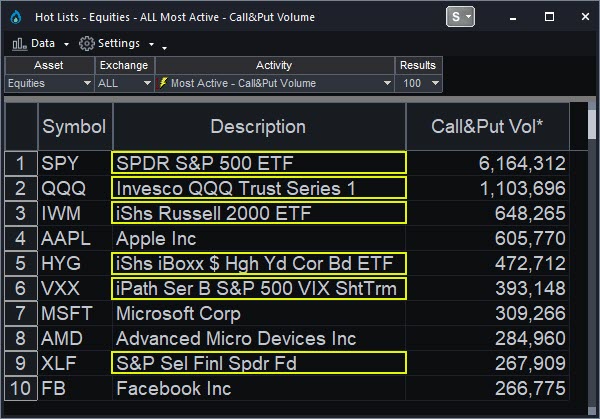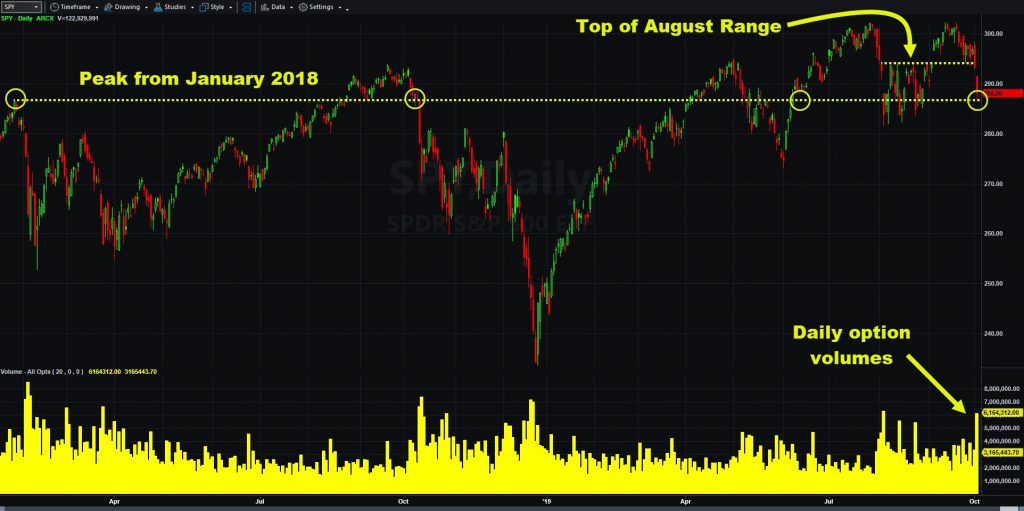Stocks fell again yesterday, illustrating three important lessons for traders.
The first lesson is that activity focuses on indexes and exchange-traded funds (ETFs) when the market crashes. For example, the SPDR S&P 500 ETF (SPY) traded more than 6.1 million options contracts on Wednesday — the most since August 5.
SPY also accounted for 23 percent of all volume in the entire options market, its highest proportion since the Christmas Eve crash.
How to apply this to your trading? One way is to avoid individual stocks when volatility sweeps the market. Big professionals watch the broader flows of money and use indexes to allocate billions of dollars over short periods of time.
If they’re ignoring individual stocks, why should you give them lots of attention?

Fortunately, TradeStation offers several ways to take positions in big indexes like the S&P 500:
- SPDR S&P 500 ETF (SPY) tracks the S&P 500 closely. Its shares are one of the most active instruments in the entire market.
- SPY options: SPY trades huge numbers of calls and puts, letting investors quickly position for moves up or down in the S&P 500. The ETF’s heavy options volumes make it super-liquid, resulting in tighter bid/ask spreads.
- CME’s S&P 500 E-mini futures (@ES) track the S&P 500, trading virtually around the clock. It also has micro contracts. Even though futures are totally different from stocks and ETFs, @ES and SPY follow the same key index.
Stocks Held a Potentially Key Level
The second important lesson is that major benchmarks like the S&P 500 tend to move between certain key levels. Investors remember these prices for months or even years.
Two important levels were at play yesterday. The first was 2940, a resistance line from August. That made it a logical place to look for support, which is probably why buyers disappeared after it broke. Without a clear level to defend, they waited.
But then they started buying about 50-60 points lower. Why there? It turns out this was near a price zone from early 2018. This shows the importance of marking index levels on your platform. Millions of investors and trillions of dollars watch these lines and wait to act on them. Shouldn’t you?

Big Investors Wait for News
The final lesson from yesterday’s big drop is that big investors wait for some kind of certainty before deploring their capital. That means big moves almost always happen after there’s clarity on news events.
In this case, everyone wants to know if President Trump and China will strike a trade deal to end more than a year of tariff fights. A positive resolution would likely restore economic confidence and trigger buying, while a non-resolution would be just the opposite.
Given that kind of uncertainty, with more than a week until Beijing’s negotiators arrive in Washington, the S&P 500 was trapped. What else could it do but skid lower as everyone waited for clarity?
Finally, remember that the key word is “clarity.” It could come in the form of a Presidential tweet or comments from China. Investors don’t need to see a deal actually signed. They just need to believe an outcome is real.
In conclusion, Wednesday was a rough session. The S&P 500 had its biggest drop since Trump “ordered” U.S. companies to find “an alternative to China” on August 23. A lot of people probably saw their accounts lose value. But there were some key lessons that might help you with your trading in the future.























